 W
WThe Apple Adjustable Keyboard is an ergonomic keyboard introduced by Apple Computer, Inc. in 1993 for the Macintosh family of personal computers. The keyboard attaches to the computer via the Apple Desktop Bus port. The last Apple computer released compatible with this keyboard without using a USB to ADB adapter was the Power Macintosh G3, as it was the last one with the Apple Desktop Bus.
 W
WThe Apple Extended Keyboard is a keyboard that was first sold separately alongside the Macintosh II and SE starting in 1987. It was replaced in 1990 by the Apple Extended Keyboard II which was pre-packaged with Apple Professional Desktops starting with the Macintosh IIsi.
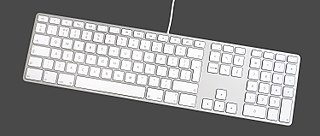 W
WApple Inc. has designed and released dozens of keyboard models since the introduction of the Apple II in 1977. The current models in use are dual-mode keyboards with integrated batteries: Magic Keyboard, and Magic Keyboard with Numeric Keypad. Both share a similar look and feel, based on a very thin aluminum chassis and laptop-style low-profile keys, sitting much closer to the tabletop than traditional keyboard designs.
 W
WThe Apple Wireless Keyboard is a wireless keyboard built for Macintosh computers and compatible with iOS devices. It interacts over Bluetooth wireless technology and unlike its wired version, it has no USB connectors or ports. Both generations have low-power features when not in use. It was discontinued on October 13, 2015, and was succeeded by the new Magic Keyboard.
 W
WCyKey is a one-handed chorded keyboard, catering to both left- and right-handed users. It features nine keys, grouped into three sets of three.
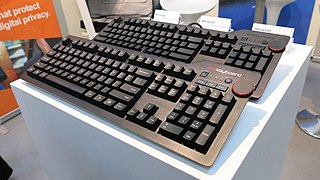 W
WDas Keyboard is a series of computer keyboards sold by Metadot Corporation, a software company located in Austin, Texas. Some models feature blank keycaps, supposedly to help improve touch typing skills and eliminate the need to rearrange keys for alternative keyboard layouts. Labeled versions have also been available since 2008. The current iterations employ mechanical keyswitches manufactured by either Cherry or Greetech. It is worth to note that "the keyboard" in German is "die Tastatur", not "das Tastatur".
 W
WThe DataHand is an unconventional computer keyboard introduced in 1995 by DataHand Systems, Inc, designed to be operated without any wrist motion or finger extension. It was invented by Dale J. Retter and produced by Industrial Innovations as early as 1992. It consists of two separate "keyboards", one for the left hand and one for the right. Each finger activates five buttons: the four compass directions as well as down. The thumbs also have five buttons: one inside, two outside, up and down.
 W
WFrogPad is a small chorded keyboard about the size of a numeric keypad that can be used with one hand. It was produced by Frogpad Inc.
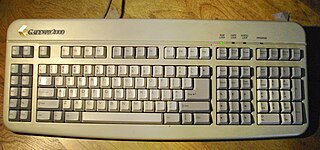 W
WThe Gateway AnyKey is a programmable PC keyboard that was sold with desktop computers from the Gateway 2000 company roughly from 1990 to 1997. It was manufactured in at least five known versions and incarnations by Tucson, Arizona-based Maxi Switch, now a subsidiary of LiteOn Technology Corporation. The AnyKey is no longer manufactured, with the latest dated model available marked 1997. Maxi Switch, Gateway, and LiteOn currently do not offer any product labeled as or comparable to the AnyKey.
 W
WThe Happy Hacking Keyboard is a small computer keyboard produced by PFU Limited of Japan, codeveloped with Japanese computer scientist and pioneer Eiiti Wada. Its reduction of keys from the common 104-key layout down to 60 keys in the professional series is the basis for its smaller size while retaining full key size. It returns the control key to its original position as on the early 84-key IBM Personal Computer/AT and XT layouts. The current models in production are the Happy Hacking Keyboard Professional Classic, Professional Hybrid, and Professional Hybrid Type-S all in either dark or light colorways, and either blank or printed keycaps. Professional Hybrid models are also available in Japanese layout.
 W
WThe IBM ThinkPad 701 is a subnotebook series from the ThinkPad line by IBM consisting of the 701C and 701Cs models based on the Intel 486. The 701 is colloquially known as the Butterfly ThinkPad due to its sliding keyboard, which was designed by John Karidis. It was developed from 1993 and sold from March 1995 until later that year and priced between 1499 and 3299 USD. The 701 was the most sold laptop in 1995 and has received 27 design awards. The series was discontinued due to newer laptops having larger screens.
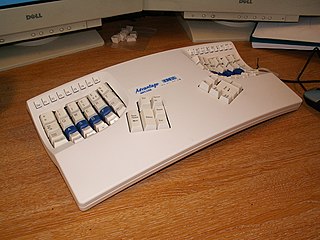 W
WThe Kinesis line of ergonomic computer keyboards is an alternative to the traditional keyboard design. Most widely known among these are the contoured Advantage line, which feature recessed keys in two bucket-like hollows which allow the fingers to reach keys with less effort as well as a central array of modifiers such as enter, alt, backspace, control, etc. where they can be pressed with the thumbs. All Kinesis keyboards support the capability to re-map individual keys. Recent models also come with the ability to switch between the Dvorak layout with the press of a special key combination, though keycaps printed with dual-legend QWERTY/Dvorak letters are included only on specific models. Moreover, the keys are laid out in perfect vertical rows to avoid the need for lateral movements during typing.
 W
WThe LK421 was a detachable computer keyboard manufactured by Digital Equipment Corporation of Maynard, Massachusetts and supplied as an option to the standard LK401 keyboard with their DEC 3000 AXP workstations. The keyboard is optimized for use with the Digital Unix line of operating systems, instead of the OpenVMS operating system for which the LK401 was more suitable.
 W
WThe Magic Keyboard is a family of wireless computer keyboards produced by Apple Inc. The keyboards are bundled with the iMac and Mac Pro and sold as standalone products, replacing the Apple Wireless Keyboard product line. Each Magic Keyboard model combination has a compact or full-size key layout for a specific region, a function key or Touch ID sensor next to F12, and color scheme variant.
 W
WThe Magic Keyboard for iPad is a computer keyboard for the iPad Pro and iPad Air, produced by Apple. It was announced in March 2020 with an original release date of May 2020, but it was subsequently made available to order in mid-April. Deliveries started later that month. It is available alongside the Smart Keyboard and Smart Cover. A white version was released on April 20, 2021.
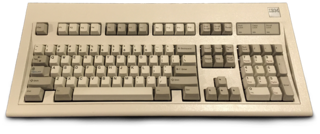 W
WModel M designates a group of computer keyboards designed and manufactured by IBM starting in 1985, and later by Lexmark International, Maxi Switch, and Unicomp. The keyboard's many variations have their own distinct characteristics, with the vast majority having a buckling-spring key design and swappable keycaps. Model M keyboards have been praised by computer enthusiasts and frequent typists due to their durability and consistency, and the tactile and auditory feedback they provide.
 W
WThe Smart Keyboard is a hardware keyboard and cover designed by Apple for the 1st generation iPad Pro.
 W
WThe Smart Keyboard Folio is a hardware keyboard and cover designed by Apple for iPad Pro for 3rd generation and later.
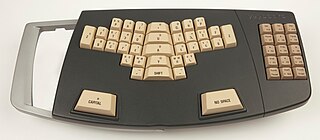 W
WVelotype is the trademark for a type of keyboard for typing text known as a syllabic chord keyboard, an invention of the Dutchmen Nico Berkelmans and Marius den Outer. In 2011 the Velotype keyboard was improved and modernized by Wim Gerbecks and Sander Pasveer. Velotype is a Dutch company.
 W
W